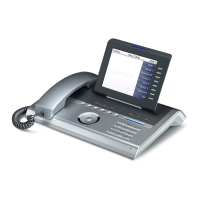administration.fm
A31003-S2000-M102-3-76A9, 08/07/2009
Asterisk - OpenStage Family, Administration Manual
3-141
Administration
Diagnostics
3.19.3 LLDP-MED
When the phone is connected to a switch with LLDP-MED capabilities, it can receive a VLAN
ID and QoS parameters and advertise its own network-related properties. The data is ex-
changed in TLV (Type-Length-Value) format.
Both sent and received LLDP-MED data can be monitored at the administrator interface.
For a network configuration example that shows LLDP-MED in operation, please refer to
Section 4.4, “An LLDP-Med Example”.
Displayed Data
• Extended Power: Power Consumption; relevant for PoE.
• Network policy (voice): VLAN ID and QoS (Quality of Service) parameters for voice trans-
port.
• Network policy (signalling): VLAN ID and QoS (Quality of Service) parameters for sig-
nalling.
• LLDEP-MED capabilities: The LLDP-MED TLVs supported by the phone and the switch
as well as the specific device class they belong to.
• MAC_Phy configuration: Identifies the possible duplex and bit-rate capability of the send-
ing device, its current duplex and bit-rate capability, and whether theses settings are the
result of auto-negotiation during the initialization of the link, or of manual set override ac-
tions.
• System capabilities: The devices advertise their potential and currently enabled func-
tions, e. g. "Bridge", "Telephone".
• TTL: Time To Live. This parameter determines how long the TLVs are valid. When expired,
the devices TTL will send a new set of TLVs.
>
For details on LLDP-MED, please refer to the ANSI/TIA-1057 standard.

